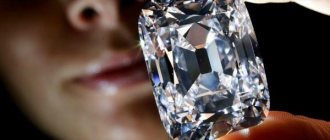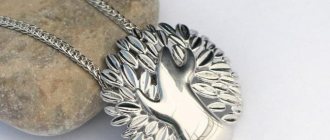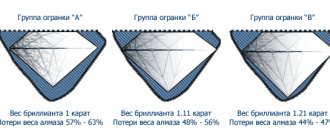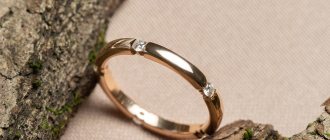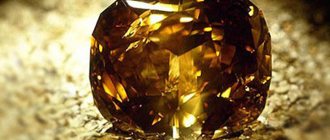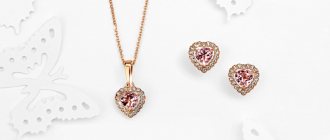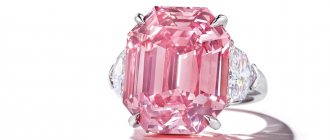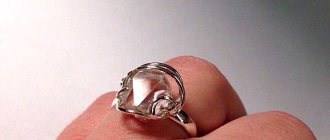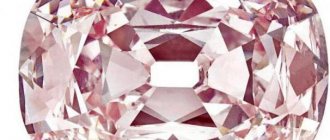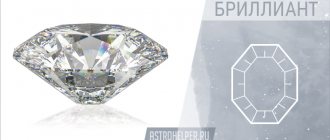From ancient times to the present day, jewelers have come up with a huge number of different types of jewelry. It would seem that now it is no longer possible to create something fundamentally new. However, the Japanese jeweler Hidetaka Dobashi clearly did not agree with this, who presented special jewelry at an exhibition in Hong Kong in June 2012 - “dancing” diamonds .
One of the main properties of diamonds is their unique ability to completely reflect light within themselves and return it back, decomposing it into different parts of the spectrum. We say that the stone “plays” or “burns.” This play occurs when the diamond moves slightly relative to our view.
Hidetaka Dobashi created an unusual “sparkling setting” for diamonds that makes them move intensely by simply shooting out light.
“Dancing” diamond (click to view)
To denote this movement, he uses the term “dance”, hence the name “dancing” diamonds.
Prices
In the catalog of a network of jewelry stores, prices for jewelry from the “Dancing Diamond Air” collection are as follows:
- ring – from 58,000 rubles;
- suspension – from 34,000 rubles;
- bracelet – from 160,000 rubles;
- earrings – from RUB 73,000;
- necklace – from RUB 39,000;
- studs – from 76,000 rub.
The cost of the products depends on the number of stones used, their dimensions, weight and what metal is used to make the frame (white, yellow or red gold).
The cost of jewelry made to order is calculated individually.
When purchasing jewelry, each crystal must be examined with a magnifying glass to make sure there are no small cracks, chips, scratches or unwanted inclusions.
Where else to buy?
Citizens of the Russian Federation can purchase products with dancing diamonds:
- In a chain of retail stores owned by .
- In one of the 140 jewelry stores of the “Lines of Love” network, located in sixty cities of Russia, which are official representatives of jewelry (Kostroma).
- In the online store "Moscow Jewelry Factory".
- In branded sections (they are available in almost all major jewelry stores) or in Sokolov flagship stores. This brand also has an official online store.
- In the Adamas chain of jewelry stores.
- B (there are more than 350 of them in Russia).
The technology for making jewelry with dancing crystals is not a secret development and is widely used by jewelers all over the world. Similar products from the famous Italian brand Roberto Bravo are very popular among Hollywood movie stars.
In Russia, the production of jewelry of this type is carried out by:
- Bronnitsky Jewelry Factory.
- Jewelry, located in the Kostroma region (its products are known on the market under the Sokolov brand).
- Muz (Moscow jewelry factory).
Is it worth buying?
The answer to this question should be based on personal preference:
- Jewelry with dancing diamonds, mesmerizing with the beauty of their enchanting radiance, is ideal for extravagant ladies who love to be the center of everyone's attention.
- Modest girls who prefer stones that emit a muted soft glow are better off opting for classic pieces.
Price and is it worth buying dancing jewelry?
People who like to attract attention prefer to wear exclusive jewelry. If you prefer a more modest lifestyle, then it is better to choose classic options.
In Russia, the dancing diamond is offered for sale by Bronnitsky Jeweler. Prices for products with dancing adamas in a jewelry store:
- pendants from RUR 34,090;
- rings from RUB 58,990;
- earrings from RUB 73,890;
- bracelet from RUB 160,390;
- piercings from RUR 43,990
The cost depends on the size, weight, metal. Prices for making orders based on your own design are calculated individually.
Before purchasing, examine the gem under a magnifying glass. There should be no cracks, no inclusions, no scratches. Make sure the fastening is secure.
About the cost of products
Let's say a few words about the price. So, a gold ring with a dancing diamond can be bought for 70 thousand rubles. Moreover, it will be made of 585 white precious metal. The central floating stone has 57 facets and weighs 0.167 carats. The frame uses 18 small stones, 0.072 carats each. The purity of all minerals is rated 5, which indicates high quality. A decoration with similar characteristics, but without small stones in the frame, will cost 56 thousand rubles.
Earrings with diamonds weighing 0.337 carats can also be purchased for 70 thousand rubles. 585 red gold is used here. But jewelry made of white gold with slightly larger stones – 0.36 carats – has approximately the same price. Round cuts are used throughout, and the stones themselves are mounted on two supports, allowing them to remain dancing.
The cost of the products includes the cost of the precious metal, so it is logical that, weighing much less than rings or earrings, the pendants will cost less. For example, a pendant made of white gold with a floating diamond has a price of about 35 thousand rubles, although the stone inserted into it is similar in size and other characteristics to the crystal from the ring described above.
What is a "dancing diamond"
A special type of jewelry is presented by Russian and foreign jewelry - “Chopard”. A dancing, or floating, diamond is an improved design for framing a mineral.
Traditional options involved fastening the stone using a rigid or semi-rigid type. At the same time, it was securely fixed in the frame and did not move. The glow appeared only in the light with pronounced body movements or when the product was deliberately moved.
Improved innovative technology promotes flickering at the slightest movements.
In the video, decoration using this technique:
Construction device
The essence of the design of a dancing diamond is to fix the stone in two places on the inside of the product. In this case, there is no contact with the wearer’s body or clothing.
Thanks to this, even with slight movement (even with a sigh), the gem begins to sway pendulum-like, shimmering and sparkling in the light. It is similar to a dance, which is why it gets its name. It seems that the gem is constantly shimmering, without ceasing.
To convey the beauty of the invention, the diamond must be of good quality and highly cut.
Types of products:
- Pendants of different sizes with dancing diamonds, decorated with precious metals: yellow, white, red gold.
- Rings made of white, yellow, red gold.
- Earrings: classic, studs, chandelier earrings made of any gold.
- White gold bracelet.
- Piercings made of different types of gold.
You can purchase not only a finished product, but also order a piece of jewelry with an individual design. And besides a diamond, you can use any other precious stone.
See how a product with these stones looks in real life:
The history of the creation of the “dancing diamond”
Hidetaka Dobashi
In traditional jewelry, the “king of stones” is attached motionlessly - they have a rigid support. In stationary products the play of light is not visible; they need to be viewed from different angles to see the “burning” in different colors.
The Japanese master Hidetaka Dobashi came up with a special type of frame design. In this design, the gem is fixed in such a way that at the slightest movement it begins to vibrate, since it is fixed at only two points of support and does not come into contact with either the clothing or the body of its “bearer”.
Dobashi is the founder of the jewelry company and inventor. In addition to the “dancing” mount, he developed magnetic decorations for glasses. He also came up with a special cutting method that allows you to get a cross-shaped glow.
The idea, as the author of the invention himself says, to use such a mount came to him in 2010. He made many attempts to achieve the desired effect, ruined many stones, but by 2013 he managed to achieve his goal.
Note that dancing diamonds did not immediately create a sensation. At first, Mr. Dobashi’s invention was more than skeptical, but he did not give up and made a whole collection.
When 145 pieces of jewelry with an unusual presentation were already presented at the exhibition in Hong Kong, well-deserved success came. And in 2014, the “dancing diamond” was patented by a Japanese jeweler and began its solemn procession across countries.
Extraordinary properties
For many years, jewelers painstakingly studied the art of cutting in order to emphasize the “fire” inside the diamond. However, before Hidetaka Dobashi, it never occurred to anyone to make a dynamic frame for it, to get rid of the static nature of jewelry.
"Dancing" diamond
So, “dancing diamonds” is the name of a special type of jewelry in which the diamond is attached to the pendant in such a way that it cannot remain in one position. In conventional methods of fastening diamonds, there is always a rigid support that prevents the movement of the stone. Hidetaka Dobashi got rid of restrictions. He came up with a double-sided support that limits the stone on only two sides. Thus, the stone constantly sways under its own weight.
The peculiarity of such a “dancing” stone is its continuous flickering. This allows you to see and fully appreciate how a diamond can “burn” in different colors. In static jewelry, this property is not so clearly revealed: in order to admire the shine of the stone, it must be moved and positioned differently relative to the light source.
Reviews
Reviews from customers who own jewelry with dancing stones are full of rave reviews.
The advantages of these products, in their opinion, are:
- The ability to emit continuous flickering as a result of imperceptible impulses (for example, during breathing and even rapid heartbeat) emanating from their owners. As a result, the owners of exquisite jewelry, emitting cascades of dazzling flashes, find themselves in the center of admiring attention from others.
- The highest quality (manifested in the impeccable coloring and ideal purity of the stones) and the impeccable cut of the diamonds used to make jewelry.
- In the extraordinary reliability of fastening the stones, “dancing” in an almost imperceptible frame.
The number of people who do not share the enthusiasm of fans of a fashionable novelty is very small. From their point of view, continuously twitching crystals emitting a trembling glow cause nothing but irritation.
Jewelry sensation
Admiration came a few months later at another exhibition, in which the entire collection of jewelry with dancing diamonds participated. Pendants, pendants, rings and earrings performed their lively dance in such a way that they literally captivated everyone.
Their movement was so smooth that many wanted to immediately purchase earrings with floating diamonds. Many investors immediately agreed to work with Dobashi. He received a patent for his invention.
Before this sensational discovery, jewelers used static methods to set gemstones. With rigid or semi-rigid fixation, cut diamonds could not move; they could not be called dancing. They only shone when the owner made a sudden movement or when a bright light was directed at them.
Now everything has changed. Jewelry with floating diamonds can constantly play with light.
Dancing diamond in jewelry (video)
We also recommend reading:
The history and curse of the Kohinoor stone The marvelous ametrine stone Characteristics of larimar and its main properties Selection of stones by date of birth
Thus, the dancing stones began to move only under the influence of their own weight.
Compared to ordinary versions, the dancing diamond has its own unique characteristics. Its key feature is that it flickers continuously as it moves continuously. This is what makes it possible to appreciate all the amazing properties of this crystal. Asking the question why earrings with a dancing diamond and other products were created, we can say with confidence that it was not possible to reveal all these unique properties in static jewelry. Therefore, the need arose to create a mineral that dances. Thanks to its constant movement, each buyer can admire the original glow of the mineral.
History of origin
Since 1980, the famous jeweler Dobashi has been actively selling his own jewelry. During that period, he opened a well-known company called Crossfor Co, where he sold products. One of his developments was a ring with a dancing diamond, but before that his achievements included a huge number of various developments. First of all, all his activities were aimed at studying the unique properties of precious stones.
The cut that the jeweler came up with was completely new and had never been used before. Its peculiarity was that it made it possible to obtain a so-called cross-shaped glow. It was achieved due to the special arrangement of 46 faces of the mineral. Therefore, a pendant with a dancing diamond and other jewelry are now quite original.
In 2012, a large-scale jewelry exhibition was held in Hong Kong, where a Japanese jeweler was able to present his first samples of dancing stones. But, as it turned out, they did not particularly impress those who saw them. Therefore, Dobashi took up the task of improving it, in the process of which he ruined more than one hundred stones.
In fact, success came to the jeweler much later. Literally a few months later, the next exhibition took place, where purely dancing products were presented. Of the 145 samples, it was Dobashi’s collection that created an incredible sensation.
Today, the boundaries have been significantly expanded, and now such dancing jewelry is made by many manufacturers who deserve only positive reviews. Chopard is rightfully considered one of the largest brands. Among domestic manufacturers, the company located in Bronnitsy, called “Bronnitsky Jeweler,” deserves special attention. When making a dancing diamond, the Bronnitsky jeweler uses only the best technologies that were proposed by Dobashi.
History of decoration
Before the invention of movable fastenings, jewelry used a rigid or semi-rigid type of fixation, and the properties of the stone appeared only in bright light or sudden movements of the owner. Floating stones made it possible to see all the beauty of the cut even with the slightest fluctuations.
Hidetaka Dobashi has been involved in gemology for a long time and in the 90s he patented a new cutting method called Crossfor, when the diamond has 46 facets giving a cross-shaped shine.
When developing the concept of a new unusual piece of jewelry, the Japanese jeweler was guided by several principles:
- the stone does not come into contact with the owner’s body, being hidden from him by any part of the decoration;
- fastening is carried out on two movable supports in such a way that any movement causes a pendulum-like sway of the stone;
- A diamond mounted movably must be of very good quality, highly cut, so that the play of light in the facets emphasizes its purity.
The Japanese jeweler’s idea did not immediately receive a response from jewelry manufacturers. Only after the Hong Kong exhibition, where about 150 products made using floating stones were presented, was the original find truly appreciated. Subsequently, the shining frame received an international patent, valid in Europe, the USA, China and India.
Currently, dancing stones are used in the jewelry of such a jewelry giant as Chopard, and in Russia they are widely represented in the “Dancing Diamond” collection.
Innovative technology for creating unusual jewelry allows diamonds to literally come to life, delighting the owner and others with a unique play of light. The dance of the stone is mesmerizing and makes you want to watch it endlessly, as evidenced by the reviews.
Teaching diamonds to dance
A dancing diamond can be created in many ways.
First of all, you can fix the stone in the caste just as statically and add dynamics to the caste.
The cast is not soldered to the product, but is hung on two rings on the sides. Thus, the caste with the stone is always “facing” those around them, but is constantly moving. This movement gives the diamond the dynamics required for play.
Another version of dancing setting, when the jeweler does not fix the stone statically, but deliberately allows it to move.
The culet (lowest point of the stone) is placed on a special lower part of the caste. One prong is adjacent to the platform (top of the stone). Since the prong does not press the stone tightly, it has the opportunity to waltz - spin around its axis.
Classic diamond setting
In a classic setting, the diamond is set statically in the castes. Caste is a piece of jewelry that is designed specifically for setting a stone.
The lower part of the stone (pavilion) must always be free. It provides shine and play to the stone. If the stone rests against gold or is surrounded by it on the sides, then it will lose the ability to play.
Therefore, the jeweler’s task is to hang the stone and allow light to pass through it as freely as possible.
The stone is held on the girdle (the widest part), so it does not fall inside. To prevent it from falling out, its crown (the upper part of the stone) is pressed with prongs. A prong is a small “foot” that floats onto the stone from above.
The prong is wrapped around the girdle. And everything together is called caste.
Since the stone is installed statically, it begins to play only when the decoration moves in space. If it is a ring, then the play of the stone begins when you move your hand. Diamonds in earrings or pendants will sparkle when you move. If the jewelry just lies on the table, you will never see the sparkle that distinguishes a diamond from all other stones.
That is why, in order to improve the play of the stone, jewelers are moving away from static settings and strive to give the diamond dynamics. A dancing diamond allows the beauty of the stone to be revealed much better.
What is the invention
In order to understand how the innovation invented by Mr. Dobashi is expressed, let’s first consider how traditional gems are attached.
There are only two ways:
- Rigid fixation of the stone in the decoration. With this method, the stone can only move together with the entire decoration. For example, a diamond ring.
- The stone is fixed at one point, “suspended”. This mount is used for pendants and earrings. If the jewelry sways when the owner moves, then the stone sways, but such vibrations quickly die out.
Hidetaka Dobashi's invention is aimed precisely at ensuring that the slightest movement - even a sigh - causes the diamond to vibrate, although the jewelry itself is not particularly affected.
He managed to achieve this through an unusual fastening design - the stone in it is limited to two points of contact. Due to this, he literally comes to life, plays, “dances.”
How do dancing diamonds work?
If we look at the usual methods of fixing diamonds in jewelry, we can identify only two main ones. First, the diamond is rigidly fixed to the jewelry and moves only with it. This is how stones are secured in almost all rings and many other types of jewelry. Secondly, the diamond is located on a pendant with one attachment point. If this pendant does not touch the body or clothing when worn, the stone in the jewelry can move relatively freely with a low frequency, which quickly fades.
Hidetaka Dobashi came up with a fairly simple, but very unusual frame design. It always adheres to two principles.
First: the stone in the setting never touches the clothing or body of the owner of the jewelry. If required, it is covered from behind with some part of the decoration.
Second: the frame of the stone has a special shape and is attached to two points on the inside of the jewelry. The design of the diamond in the setting is balanced so that the slightest movement of the jewelry causes it to oscillate frequently.
Is it worth buying “dancing” jewelry?
It is quite clear that everyone has different tastes. Some people like everything classic, he (or rather, of course, she) is not ready to experiment with “eternal values”, but others are simply delighted with everything unusual.
It's up to you to decide. If you think that a diamond in a piece of jewelry should glow softly and subduedly, then your direction is classic.
If you like enchanting sparkle more, and you are ready to attract the attention of others, then the “dancing diamond” is simply created for you.
In Russia, “dancing” pebbles are promoted and sold in the retail network.
Is it worth it or not to buy “dancing” jewelry?
Opinions about jewelry with “dancing” stones (diamonds or others) are predictably divided. Some people absolutely do not like the too frequent and sharp “trembling” or “twitching” of a diamond. In classic versions of jewelry, the stone shimmers with light more smoothly, following the pace of movement of its owner. Others like the expressiveness and independence of the diamond, which creates fireworks of light with any movement of the jewelry, always attracting attention.
In any case, “dancing” diamonds are a very unusual idea and will definitely find their buyer.
Where to buy dancing diamonds in Russia?
In Russia, this type of jewelry is promoted by the Bronnitsky Jeweler company. Surely many have seen advertisements for this unusual method of attaching pendants and earrings. Accordingly, you can buy dancing diamonds in the Bronnitsky Jeweler retail chain.
PRECIOUS STONE DIAMOND
List of the largest diamonds weighing over 100 carats | Largest Diamond - Golden Jubilee | The largest diamond
Famous collection
Earrings with diamonds are especially expressive if the stones in them are movable, that is, dancing. They are also often inserted into pendants or pendants. For example, specialists from some companies decorate the watches they produce with playing crystals.
A ring with a floating diamond or ring is less common, but they still attract attention. There is a collection that includes magnificent rings, where the stone is fixed on two movable supports. Its edges, when swayed, create a real rainbow. 585 gold (yellow, red, white) is used for framing.
Collections can contain not only classic earrings with diamonds, but also chandelier earrings. The illusion of flickering lights intensifies when you turn your head. When walking uniformly, the rays directed from the stone also move smoothly.
Dancing diamonds set into pendants and pendants are framed in elegant gold and platinum frames. They look like traditional hearts, blobs, or even space designs.
Jewelry from a Russian manufacturer
Dancing diamonds from Bronnitsky Jeweler are represented in the collection by several types of products that have firmly won the highest places in the ranking of the factory’s products. These include:
- Rings made of 585 yellow, white and red gold. The stone, fixed on two movable supports inside the ring, swaying, creates a rainbow play of light, shimmering with all its faces.
- Earrings made in a classic style, studs, chandelier earrings, made of different types of gold. When walking or turning your head, the stones begin to tremble, creating the illusion of flickering lights.
- Pendants of different sizes, also made of 585 white, yellow or red gold. The stone, swaying at the slightest movement, dances, attracting attention with its tints and play of light.
In addition to collectible items, at the Bronnitsy jewelry factory you can purchase custom-made jewelry that will use a movable type of fastening. In the catalog you need to select the size of the gemstone and the appropriate frame, and then place an order for an individual design.
What other unusual settings for diamonds are there?
In the “dancing” look, they offer pendants and earrings with traditional stone fastening, but the pendant itself is separately movably attached.
Another way is to use a laser to make a hole in the diamond itself, through which it is attached to the jewelry. If the first method is quite common and has been used for a long time (but should not be passed off as “dancing”), then the second is dubious and very rarely used, because then the diamond is irreparably damaged.
The Secret of the Stone Dance
The Japanese master, creating a dancing diamond, used several basic principles:
- the gemstone in the product should not touch the owner’s body or clothing;
- fastening on two supports allows the stone to oscillate like a pendulum with any movement;
- Only diamonds of the highest quality are used so that the play of rays, thanks to the cut, enhances their purity.
In order to fulfill the first requirement, there is always a piece of jewelry between the stone and the body or clothing of the owner. The second feature is that the two clamps used provide the diamond with the ability to react even to the heartbeat. This effect is very noticeable in the case of dancing diamonds in pendants located on the chest.
It happens that a gem is attached to a piece of jewelry without using a setting. To do this, using a laser beam, a through hole is made in the crystal, into which a thin platinum wire is inserted. A diamond is like a bead that is movable, has the ability to rotate and shimmers, reflecting light. But this is not considered a very good method, since, in fact, the stone will be damaged by such a cut.
Unique properties of the mineral
It has been known for a long time that such pebbles have excellent refractive properties. In order to highlight all the unique properties of this mineral, experienced jewelers have been studying various cutting options for many years. But no one except Hidetaka Dobashi was able to get rid of the static nature of jewelry with such a mineral and give it dynamism. It was the Japanese master who developed the so-called dancing diamond. It was he who was able to revive these minerals.
Brand new are items sold in jewelry stores that use a dancing diamond. This is a completely new production technology that involves fastening the stone into a product in such a way that it becomes movable. They say he starts dancing. Previously, when attaching them, only a rigid support was used, which prevented the slightest movement. Hidetaka Dobashi got rid of such restrictions. He came up with a special support that could limit the mineral on only two sides.
Adding an elite metallic shine
Buyers are often interested in what the name “Rhodium-plated Diamond” is, and whether the stone is actually coated with a layer of platinum group metal. This concept is not true and there is no need to repeat it pointlessly.
A diamond is not a metal and cannot be plated with rhodium.
But applying a thin layer of rhodium to the metal part of the jewelry allows you to give it an elite appearance, and therefore increase consumer interest.
Due to its high hardness and strength, rhodium reliably protects the product from external damage, and uniform galvanic application allows you to hide the smallest scratches and roughness.
Against the background of a rhodium-plated frame, the diamonds sparkle well in the sun. The rays are reflected from the edges and will sparkle with all the colors of the rainbow. Most often, items made of white gold and platinum are rhodium-plated. Due to the high cost of rhodium, coating silver with it is considered unprofitable.
The main disadvantage of this method of improving the color of diamond jewelry is that the rhodium layer wears off over time and stains of the base metal become visible.
This is the main reason why rhodium plating is not recommended for rings and rings made of yellow and red gold. Such jewelry must be regularly taken to a workshop to restore the rhodium layer, which is impractical and expensive.
Types of stone cuts
In order for the mined diamond to shine with all its enchanting shades, it must be processed and cut. Jewelry craftsmen use different types of cutting of precious stones. Among them, the most common are the following:
- Improved. With this cut you can achieve fancy diamond shapes. Such stones shimmer magnificently when light hits them. The main shapes of the improved cut are: trillion, marquise, heart, teardrop, or pear, oval.
The disadvantages of this cut are the fragility of stones compared to round cuts. Also, if there are flaws in the stone, they will be visible.
- Round. This cut is the most popular and in demand. The round cut is most often found in dancing diamond jewelry. The number of edges of this cut is 57. This is the number that helps achieve the greatest play of light when mounted in a frame.
It is believed that diamonds cut in this way are the most durable. The only significant drawback of this cut is the large proportion of stone that is lost during cutting.Jewelry with round diamonds is some of the most expensive in the world. There are two types of round cut. Type A cut is ideal in its structure, since all faceted areas are proportional to each other. Type B cut is asymmetrical; sections of the stone can be stretched both in height and in diameter.
- Stepped.
This cut shape helps produce a rectangular or square shaped diamond. Most diamonds of this cut have sharp corners that are ground down. This cut helps preserve the weight of the gemstone as much as possible, thereby increasing the number of carats. Step cut diamond shapes include rhombus, baguette, trapezoid, kite, emerald, asscher. However, with this cut, the stones lose a little of their shine, and due to their small size, flaws become visible in them. - Mixed.
Combines advanced and step cuts. It comes in the following forms: princess, radiant, baryon, flanders. Such diamonds are quite vulnerable, they need to be carried carefully so as not to break or scratch the corners. - Antique. One of the most ancient types of cutting, which includes the rose shape, European and antique. Diamonds of this cut are quite massive and have a lot of weight.
How to wear?
- Jewelry with dancing diamonds (especially earrings and pendants), mesmerizing with the iridescent shimmer of crystals exclusively in evening light, is appropriate only in combination with expensive evening dresses. They are completely unsuitable for creating everyday images, since in everyday life and in daylight, stones that have lost their dazzling shine can be mistaken for ordinary jewelry.
- Accessories with dancing crystals can be worn on a romantic date, private party, social event or business dinner.
- Stones that are in constant motion look best when set in yellow or white gold.
- Any item with dancing crystals is considered to be an ideal engagement gift.
What do buyers say about jewelry?
Lyudmila, 42 years old, Moscow:
The other day my husband and I bought jewelry with a dancing diamond as a gift for our beloved daughter for her graduation from university. To say that she was surprised would be an understatement. Compared to many of the products that were offered to us, the dancing mineral cannot be compared. We have never seen such incredible radiance before.
Alexey, 30 years old, St. Petersburg:
Every man knows that a girl's favorite mineral is a diamond. So I pleased my beloved girl with such a piece of jewelry. You should have seen her eyes when she opened the box with the gift. It could be said that the sparkle emitted by the stone was completely reflected in her eyes. Thank you very much to whoever came up with such an original cut. Now my beloved cannot get enough of the product and says that she has never seen such a bright stone in her life.
Julia, 29 years old, Ekaterinburg:
I spent a long time going to jewelry stores looking for a beautiful ring. I looked at a huge number of different options for rings with all kinds of stones, but settled on a dancing diamond. You know, I didn’t regret it at all. In addition to the fact that the quality is very good, the price is no more than for regular cuts.
Therefore, if you want to purchase a truly original and worthy product, pay attention to dancing diamonds.

